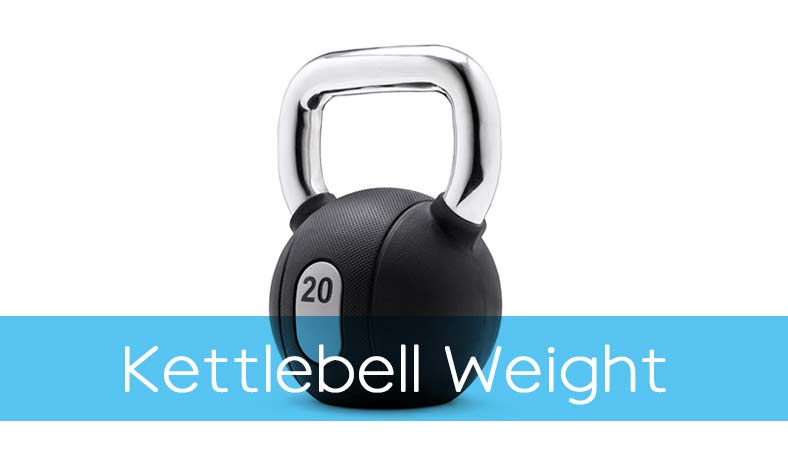Most women are more concerned with losing weight and prefer to slim down before gradually adding muscle for shaping to meet their aesthetic goals. However, upon starting a fitness journey, it becomes clear that the key is to first build muscle mass, then focus on reducing body fat and shaping your physique.
Tired of the same old dumbbell routine? Looking to add a little spice to your fitness routine? Kettlebells are a popular choice for women who want to build strength, tone up, and have fun doing it.
Give the kettlebell a try! Don’t let its cute and rounded appearance fool you – it packs a powerful punch and is much more versatile than you might think.
So, for women, how should you choose the right weight for a kettlebell workout?

In this article, we’re going to focus on kettlebell weights that are appropriate for women and how to gradually increase weight to enhance exercise intensity.
So, let’s dive in!
Contents
Introduction to Kettlebells
The kettlebell – or “girya” in Russian – is a versatile weightlifting and resistance training tool made from cast iron or steel. It’s designed to help you build muscle strength, endurance, explosiveness, and cardiovascular fitness.
Originating in Russia during the 18th century, the kettlebell’s unique off-center weight distribution allows for smooth and fluid swings.
Studies have shown that kettlebell exercises are highly effective for burning body fat. Just 20 minutes of kettlebell workouts can help you burn up to 400 calories – that’s equivalent to running 6 kilometers!
The kettlebell is an all-in-one solution that combines full-body training, uniqueness, affordability, fun, and effectiveness. It doesn’t just target one aspect of physical fitness like strength or cardio, but rather combines the benefits of muscle strength training, cardio conditioning, and muscle endurance training.
What are the benefits of kettlebell training for women?
Efficient Grease Burning
For many women, the primary goal of the exercise is weight loss, and few things are better for achieving that goal than kettlebell training.
Kettlebell exercises involve a variety of movements that work the entire body and require high levels of metabolic activity. Compared to other types of equipment, kettlebells offer higher efficiency for burning fat.
Slimmer Hips
Kettlebell swing training generates significant centrifugal force, which stretches muscles while under load and helps develop muscle size and strength.
In addition, many people today spend long hours sitting, resulting in weak hip muscles. Kettlebell training can help strengthen these muscles, improve posture, and help women achieve shapely hips without bulking up their legs. Isn’t that great?
Train Anywhere
Can’t make it to the gym? Weather not cooperating for outdoor training? No problem! All you need is a kettlebell, and you can complete your workout even in the smallest of spaces.
Choosing the right kettlebell weights for women
Kettlebells are a completely different type of weightlifting equipment compared to dumbbells and barbells. They heavily emphasize core strength and stability. Our general advice is to visit a gym and try them out if possible.
Typically, women start with an 8 kg (17 lbs) kettlebell, though those with a strong athletic ability or physique can start with a 12 kg kettlebell. Junior fitness enthusiasts generally recommend a 16 kg or 20 kg kettlebell, while heavy fitness enthusiasts recommend a 24 kg kettlebell.
If you’re unsure, start with a lighter kettlebell and gradually increase the weight as you progress, rather than the other way around. If you have no experience, it’s crucial to learn proper kettlebell training before increasing your weight.
Here’s a table that outlines recommended kettlebell weights based on different factors for women:
| Factors | Beginner (kg) | Intermediate (kg) | Advanced (kg) |
|---|---|---|---|
| Bodyweight < 120 lbs | 8-12 | 12-16 | 20+ |
| Bodyweight 120-150 lbs | 12-16 | 16-20 | 24+ |
| Bodyweight > 150 lbs | 16 | 20 | 28+ |
| Strength level | 8-12 | 12-20 | 24+ |
| Training experience | 8-12 | 12-20 | 24+ |
Please note that these are general guidelines and individual circumstances, such as injuries or medical conditions, should be taken into consideration when choosing a kettlebell weight.
Different exercises require different weights
When working out with kettlebells, the weight selected will affect which exercises can be performed.
Lighter weights are better suited for exercises that require quick movements such as swings, snatches, and cleans, while heavier weights are better suited for slower movements like squats and presses.
Moreover, the weight of the kettlebell also determines which muscles are targeted during an exercise. Lighter kettlebells are ideal for exercises that focus on smaller muscles, such as the rotator cuff and deltoids, while heavier kettlebells are better suited for compound exercises that target larger muscle groups like the glutes, quadriceps, and back.
In general, a good rule of thumb is to choose a weight that allows you to complete 8-10 reps with proper form before feeling fatigued. If you can easily complete more than 10 reps, the weight is too light, and if you can’t complete at least 8 reps, the weight is too heavy.
It’s important to remember that the weight chosen should be challenging but not too difficult. If a kettlebell is too heavy, it can lead to forming mistakes and injury, so always start with a slightly lower weight than you think you can handle and increase the weight as needed.
Risks of overweight kettlebells for women
While kettlebell training can be a great way for women to build strength and improve overall fitness, using weights that are too heavy can increase the risk of injury. Some potential risks of women using too heavy kettlebells include:
- Strains and Sprains: Lifting heavy weights can put a lot of strain on the muscles and joints, increasing the risk of sprains and strains. This risk is particularly high if proper form is not maintained during exercises.
- Joint Pain: Women who use kettlebells that are too heavy for them may experience joint pain, particularly in the shoulders, elbows, and wrists. Based on the feedback from a number of female beginners, it appears that some of them made the mistake of using kettlebells that weighed more than 15 kg (33 lbs) right from the outset of their training. This was a misstep because the weight was beyond their level of tolerance, leading to wrist pain and discomfort during their workouts.
- Lower Back Pain: Incorrect technique, especially when performing exercises such as swings or deadlifts, can result in lower back pain or even injury.
- Tendinitis: Repetitive motions or excessive force can cause tendinitis, an inflammation of the tendons that can cause pain and swelling.
To minimize the risk of injury, women should start with lighter kettlebells and gradually progress to heavier weights as they become stronger and more experienced. It is also important to maintain proper form and technique during exercises and to listen to your body and avoid pushing yourself too hard.
How to progress with kettlebell weights for women over time?
Progression with kettlebell weights for women over time can be achieved through a gradual increase in weight, sets, and repetitions. Here are some tips to help with progression:
Start with a weight that you can handle comfortably. If you are a beginner, start with a lighter-weight kettlebell and gradually increase the weight as your strength improves.
Increase the weight gradually. Once you are comfortable with a certain weight, try increasing it by 2-4kg (5-10lbs) at a time. This will help you avoid injury and ensure proper form.
Increase the sets and repetitions. As you progress with your kettlebell training, try adding an extra set or two to your workout. You can also increase the number of repetitions per set.
Incorporate different exercises. Varying your kettlebell exercises can help you avoid plateaus and keep your workouts challenging. Try different movements like swings, snatches, and cleans.
Track your progress. Keep a record of the weights you use and the sets and reps you complete. This will help you track your progress over time and make informed decisions about when to increase your weight.
By following these tips, women can progress safely and effectively with their kettlebell training over time.
Summary
In order to get the most out of your kettlebell training as a woman, it’s essential to choose the appropriate weight to prevent injuries and achieve optimal results.
As a beginner, I suggest starting with a 12 kg (17 lb) kettlebell – it’s a great starting point that won’t be too heavy or overwhelming. If you’re already familiar with exercise and fitness, feel free to adjust the weight to suit your personal needs and goals.
During kettlebell training, it’s crucial to prioritize proper form and technique to ensure your safety and avoid injury. We’ll cover more details on this topic in upcoming articles, so stay tuned!
Remember, the key to success with kettlebell training is consistency and dedication. By practicing regularly and staying motivated, you can achieve your fitness goals and lead a healthy, fulfilling life.
So, let’s get started with kettlebell training and have fun with it! Don’t hesitate to reach out if you have any questions or concerns. Together, we can create a fitness routine that works for you and helps you reach your full potential.
Chris Jordan
Hey there, I'm Chris Jordan! I'm a certified personal trainer and dietician with over 11 years of experience in the fitness industry. I've helped thousands of people achieve better physical and mental health. When I'm not working, I love spending time with my dog.

![What Weight Kettlebell Should A Woman Use? [Potential Risk]](https://lafitness.reviews/wp-content/uploads/thumbs_dir/focus-t25-workout-ppj6kzn2uvof90d1aujb9f5oq02ftbhdu8fdtq53r0.jpg)
![What Weight Kettlebell Should A Woman Use? [Potential Risk]](https://lafitness.reviews/wp-content/uploads/thumbs_dir/how-to-clean-adjustable-dumbbells-q3fjb522py00ripv5g8yk9k3qkdsa3e2k30w32s0n0.jpg)
![How to clean adjustable dumbbells? [e.g. Bowflex and PowerBlock]](https://lafitness.reviews/wp-content/uploads/thumbs_dir/how-to-clean-adjustable-dumbbells-20hj5my2115uuagb8wtleoeoy6iq4hluixjutukgq84k.jpg)
![Focus T25 Workout Schedule: Free Calendar and PDF [Video]](https://lafitness.reviews/wp-content/uploads/thumbs_dir/focus-t25-workout-1zexaab0devemj1blzta5ya8wgyalv0bq9qv34ld2v8k.jpg)

